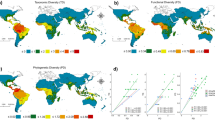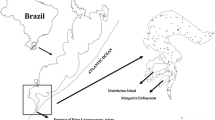Abstract
The distribution and abundance of the American crocodile (Crocodylus acutus) in the Florida Everglades is dependent on the timing, amount, and location of freshwater flow. One of the goals of the Comprehensive Everglades Restoration Plan (CERP) is to restore historic freshwater flows to American crocodile habitat throughout the Everglades. To predict the impacts on the crocodile population from planned restoration activities, we created a stage-based spatially explicit crocodile population model that incorporated regional hydrology models and American crocodile research and monitoring data. Growth and survival were influenced by salinity, water depth, and density-dependent interactions. A stage-structured spatial model was used with discrete spatial convolution to direct crocodiles toward attractive sources where conditions were favorable. The model predicted that CERP would have both positive and negative impacts on American crocodile growth, survival, and distribution. Overall, crocodile populations across south Florida were predicted to decrease approximately 3 % with the implementation of CERP compared to future conditions without restoration, but local increases up to 30 % occurred in the Joe Bay area near Taylor Slough, and local decreases up to 30 % occurred in the vicinity of Buttonwood Canal due to changes in salinity and freshwater flows.







Similar content being viewed by others
References
Brandt LA, Mazzotti FJ, Wilcox JR, Barker P, Hasty G, Wasilewski J (1995) Status of the American crocodile (Crocodylus acutus) at a power plant site in Florida, USA. Herpetol Nat Hist 3:29–36
Campos Z, Magnusson W (1995) Relationships between rainfall, nesting habitat and fecundity of Caiman crocodilus yacare in the Pantanal, Brazil. J Trop Ecol 11:351–358
Caswell H (2001) Matrix population models: construction, analysis, and interpretation. Sinauer Associates, Inc
Cherkiss MS (1999) Status and distribution of the American Crocodile (Crocodylus acutus) in Southeastern Florida. Master’s Thesis, University of Florida, Gainesville, FL
Cherkiss MS, Brandt LA, Chartier KL, Lorenz J, Miller M, Parry MW, Pearlstine LG, Rice KG, Shang Z, Mazzotti FJ (2006) The Role of the American Crocodile (Crocodylus acutus) as an Indicator of Ecological Change in Everglades Ecosystems. http://crocdoc.ifas.ufl.edu/publications/posters/crocodileasindicator/. Accessed 12 Jul 2012
Dunson WA (1982) Salinity relations of crocodiles in Florida Bay. Copeia 1982:374–385
Dunson WA, Mazzotti FJ (1989) Salinity as a limiting factor in the distribution of reptiles in Florida Bay: a theory for the estuarine origin of marine snakes and turtles. Bull Mar Sci 44:229–244
Graham AD (1968) The Lake Rudolf Crocodile (Crocodylus Niloticus Laurenti) population. Report to the Kenya Game Department, Wildlife Services Limited
Hallac D, Kline J, Sadle J, Bass S, Ziegler T, Snow S (2010) Preliminary effects of the January 2010 cold weather on flora and fauna in Everglades National Park. Homestead, FL: Biological Resources Branch, South Florida Natural Resources Center, Everglades and Dry Tortugas National Parks, p 8
Hutton J (1989) Movements, home range, dispersal and the separation of size classes in Nile crocodiles. Am Zool 29:1033–1049
Kushlan JA, Mazzotti FJ (1989) Historic and present distribution of the American crocodile in Florida. J Herpetol 23:1–7
Lefkovitch L (1965) The study of population growth in organisms grouped by stages. Biometrics 21:1–18
Mazzotti FJ (1985) The ecology of Crocodylus acutus in Florida: a thesis in ecology. Pennsylvania State University, University Park
Mazzotti FJ (1999) The American crocodile in Florida Bay. Estuar Coasts 22:552–561
Mazzotti FJ, Dunson WA (1984) Adaptations of Crocodylus acutus and Alligator for life in saline water. Comp Biochem Physiol A Physiol 79:641–646
Mazzotti FJ, Dunson WA (1989) Osmoregulation in crocodilians. Am Zool 29:903–920
Mazzotti FJ, Bohnsack B, McMahon MP, Wilcox JR (1986) Field and laboratory observations on the effects of high temperature and salinity on hatchling Crocodylus acutus. Herpetol 42:191–196
Mazzotti FJ, Brandt LA, Moler PE, Cherkiss MS (2007) American crocodile (Crocodylus acutus) in Florida: recommendations for endangered species recovery and ecosystem restoration. J Herpetol 41:122–132
Mazzotti FJ, Romañach SS, Cherkiss MS, Chartier KL, Chartier V, Brandt LA (2009) Habitat Suitability Index Model for American Crocodiles (Crocodylus acutus) in South Florida. Joint Ecosystem Modeling Technical Report
Moler PE (1991a) American Crocodile Nest Survey and Monitoring. Final Report. Study Number 7533. Bureau of Wildlife Research, Florida Game and Fresh Water Fish Commission, Tallahassee, FL
Moler PE (1991b) American Crocodile Population Dynamics, Final Report, Study Number: 7532. Bureau of Wildlife Research, Florida Game and Fresh Water Fish Commission, Tallahassee, FL
National Research Council (2002) Florida Bay Research Programs and Their Relation to the Comprehensive Everglades Restoration Plan. The National Academies Press, Washington, DC
Nichols JD, Viehman L, Chabreck R, Fenderson B (1976) Simulation of a commercially harvested alligator population in Louisiana. Bulletin no. 69. Louisiana State University and Agricultural and Mechanical College, Center for Agricultural Sciences and Rural Development, Agricultural Experiment Station
Ogden JC (1978) Status and nesting biology of the American Crocodile, Crocodylus acutus, (Reptilia, Crocodilidae) in Florida. J Herpetol 12:183–196
Pearlstine L, Smith S, Brandt L, Allen C, Kitchens W, Stenberg J (2002) Assessing state-wide biodiversity in the Florida Gap analysis project. J Environ Manag 66:127–144
Polis GA, Myers CA (1985) A survey of intraspecific predation among reptiles and amphibians. J Herpetol 19:99–107
RECOVER (2005) Interim Goal 4.4 American Crocodile. United States Army Corps of Engineers, Jacksonville District, Jacksonville, Florida, and South Florida Water Management District, West Palm Beach, Florida
Richards PM, Wasilewski J (2003) Crocodylus acutus (American crocodile) cannibalism. Herpetol Rev 34:371
Schubert A, James W, Mendez H, Santana G (1996) Headstarting and translocation of juvenile Crocodylus acutus in Lago Enriquillo, Dominican Republic. In: IUCN—The World Conservation Union Gland, Switzerland, pp 166–175
SFWMD (1997) Documentation for the South Florida Water Management Model. Hydrologic Systems Modeling Division, Planning Department, SFWMD, West Palm Beach
Shenton W, Bond NR, Yen JDL, Nally RM (2012) Putting the “ecology” into environmental flows: ecological dynamics and demographic modelling. Environ Manag 50:1–10
Slone DH (2011) Increasing accuracy of dispersal kernels in grid-based population models. Ecol Model 222:573–579
Slone DH, Rice KG, Allen JC (2003) Model evaluates influence of Everglades restoration on alligator populations (Florida). Ecol Restor 21:141–142
Swain ED, Lohmann M, Decker J, Liebscher H, Clarke R, Rodda J, Schultz G, Schumann A, Ubertini L, Young G (2009) Hydrological simulations of water-management scenarios in support of the Comprehensive Everglades Restoration Plan. In: The role of hydrology in water resources management. IAHS, Island of Capri, Italy, pp 296–305
US Fish and Wildlife Service (1999) South Florida multi-species recovery plan. Atlanta, GA. 2172pp
Wang J, Swain ED, Wolfert MA, Langevin CD, James DE, Telis PA (2007) Application of FTLOADDS to Simulate Flow, Salinity, and Surface-Water Sage in the Southern Everglades, Florida. Scientific Investigations Report 2007–5010, U.S. Geological Survey
Acknowledgments
This work was supported by USGS Greater Everglades Priority Ecosystems Science. Use of trade, product, or firm names does not imply endorsement by the U.S. Government.
Author information
Authors and Affiliations
Corresponding author
Rights and permissions
About this article
Cite this article
Green, T.W., Slone, D.H., Swain, E.D. et al. Evaluating Effects of Everglades Restoration on American Crocodile Populations in South Florida Using a Spatially-Explicit, Stage-Based Population Model. Wetlands 34 (Suppl 1), 213–224 (2014). https://doi.org/10.1007/s13157-012-0370-0
Received:
Accepted:
Published:
Issue Date:
DOI: https://doi.org/10.1007/s13157-012-0370-0




